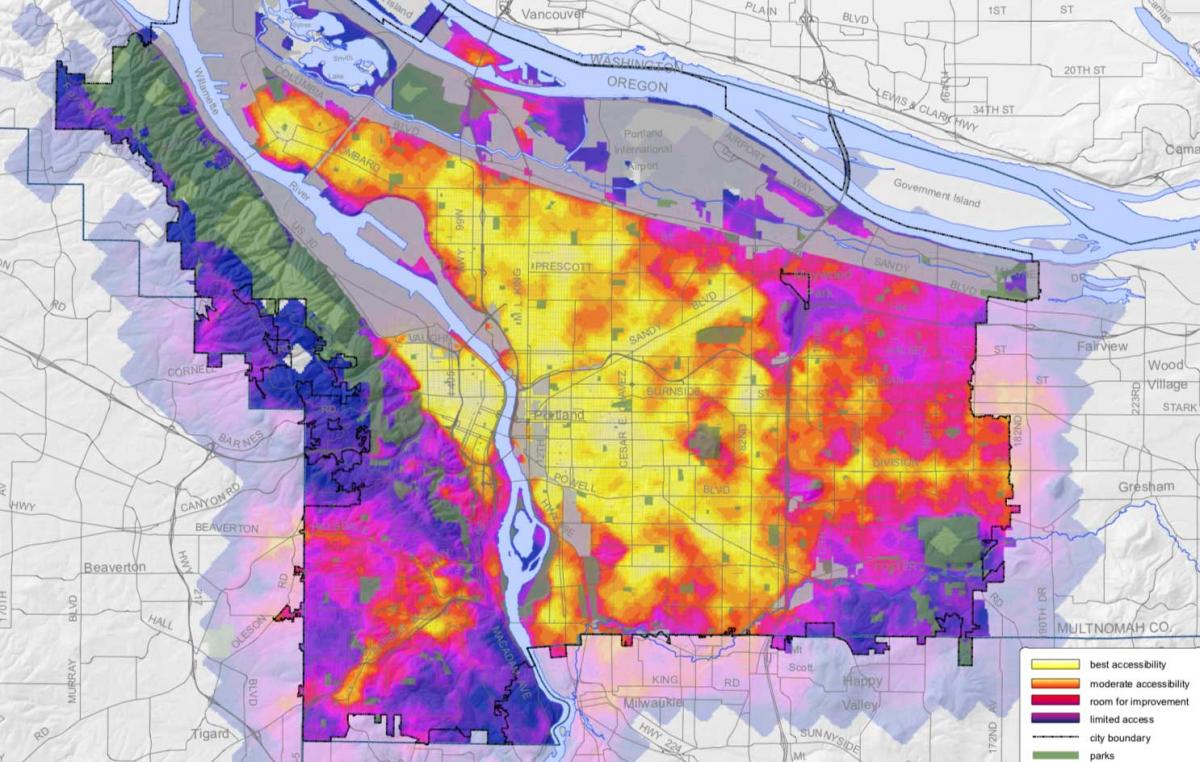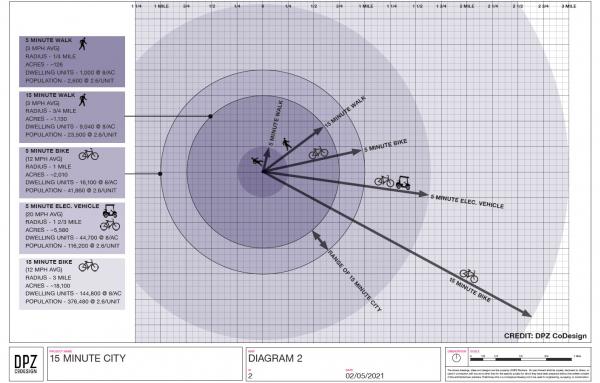
The 15-minute neighborhood gets its 15 minutes of fame
The urbanism world has been buzzing lately over “15-minute neighborhoods,” a planning concept that has recently gained international political prominence.
The phrase was highlighted in the US when former Housing and Urban Development (HUD) Secretary Shaun Donovan made it a foundation of his New York City mayoral candidacy. “Donovan proposed remaking New York as a city of ‘15-minute neighborhoods’—where all residents live within a short walk of a good school, rapid transit, a place to buy fresh food, and a park,” according to Politico. (Some CNU members will remember that, while HUD secretary, Donovan gave the keynote address to the 2010 Congress for the New Urbanism in Atlanta.) Earlier last year, in Paris, France, Mayor Anne Hidalgo touted the “15-minute City,” in her successful re-election campaign.

The phrase has roots in Portland, Oregon, where the “20-minute neighborhood” has been used as a planning concept since 2010. Planners elsewhere picked it up. In 2013, I reported on an analysis of Baltimore, Maryland, that built on Portland’s work. By 2016, Detroit’s Mayor Mike Duggan was using the “20-minute neighborhood” as a goal. Donovan and Hidalgo shaved off five minutes of time—perhaps because expectations of walkability are higher in New York and Paris. Or maybe a certain animated gecko has proven that “15 minutes” sticks in the mind better than “20 minutes.” (15-minute neighborhood tagline: 15 minutes can save you 100 percent on car insurance). Regardless, the basic concept is the same.
Now that the 15-minute neighborhood has caught the attention of politicians and the media, let’s unpack what it really means and its potential as a tool to improve quality of life and livability.

Politics and planning
As a political concept, the 15-minute neighborhood is wonderfully succinct. It emphasizes access to things that people need in their daily lives in a way that can be understood by nearly anyone. It avoids arguments over automobiles. Unlike New Urbanism, it doesn’t sound like an ideology. These qualities give the 15-minute neighborhood possible traction in a political campaign.
As a planning concept, however, I have some questions. All references to 15-minute neighborhoods stress access without needing a car—but what does that include specifically? Although Donovan emphasized walking, most proponents mention both walking and biking, and some even include transit. Hidalgo, for example, highlights both walking and biking. Boulder, Colorado, notes that “In a 15-minute neighborhood, people can access their basic needs (parks, food, etc.) within 15 minutes of walking, biking, or transit.”
The distances one can travel in these various modes, and thus the area covered, are radically different. In 15 minutes, the average person can comfortably walk about three-quarters of a mile. That implies an area of about 1.75 square miles around your home that includes a grocery store and other important destinations. With a bicycle, one can easily travel two miles in 15 minutes—and that creates a circle with an area of 12.5 square miles. That’s a much easier standard to meet. Riding transit gets you even further. Using 20 instead of 15 minutes, on a bike, defines an area of 28 square miles—whoa, that’s big.
The “15-minute neighborhood” can be squeezed or stretched substantially depending on how it is defined—and there is little agreement on that. Maybe that flexibility is an advantage when talking about radically different places. Detroit is not Manhattan, and to expect both cities to meet the same standard of non-automotive access is unrealistic.
The 15-minute neighborhood does not seem to be a standard so much as an open-to-wide-interpretation goal to improve the ability of people to get around without need of a car. That’s a goal that urbanists would surely agree on, but the 15-minute neighborhood doesn’t yet define any clear way of meeting that goal that would carry the same meaning whether you are talking to an audience in Indianapolis or San Francisco. How this concept applies to different kinds of places is a question that begs for a better response.
Barriers may be more important
The real issue, of course, is often not distance but the ability to get somewhere outside of a car. If you need to cross a six-lane arterial with fast-moving traffic, maybe everything on the other side is inaccessible by foot or bike—regardless of distance. So, is the 15-minute neighborhood about distance or barriers—or both? I live in a highly walkable neighborhood in Ithaca, New York, where most daily needs are accessible within a 15-minute walk, but not a major grocery store. I could access two medium-sized and two large grocery stores in a 15-minute bike ride—except that all four are on the other side of a major arterial thoroughfare. Limits to the 15-minute neighborhood in downtown Ithaca are mostly defined by a single barrier.
In less walkable cities, the major impediment to a 15-minute neighborhood could be the entire public realm. Most of America’s metropolitan regions were built on a model of dendritic street networks, where residential subdivisions are accessed via collector and arterial roads that carry most of the automobile traffic and also attract the commercial uses. The travel distances are farther, but access outside of a car is impractical regardless of distance.
The pedestrian shed
New urbanists have always used another primary access standard relating to time—the five-minute walk. There’s a standard that is relevant and universal. The five-minute walk, also called a pedestrian shed, is based on the typical size of neighborhoods—about a quarter mile from center to edge. The size of neighborhoods, in turn, relates the human body—a factor that has not changed over the centuries. Even today many people will choose to walk a quarter mile, if the conditions are good, rather than drive and face the hassle of parking. When you extend that radius to a mile—a 20-minute walk—you can still get there by bike in five minutes or a little longer. Hence the 20-minute (or 15-minute) neighborhood could be thought of as an extension of the five-minute walk.
What’s missing from the “15-minute neighborhood” conversation is the rigor of new urbanist thinking. New urbanists could greatly add to this dialog by analyzing more precisely what the concept could mean, and how it could be applied, in a variety of cities and towns. Without better analysis, the “15-minute neighborhood” may achieve its “15-minutes of fame”—as Andy Warhol might say—and fade with other popular shorthand terms for a walkable and livable city. That would be a shame, because there’s more substance to this concept than one can find in a currently popular soundbite.
NOTE: See the article “Defining the 15-minute city” for details on what this concept means for planners and urban designers.







